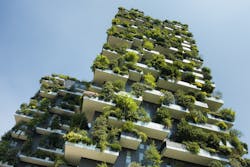Repair with Regenerative Design: A New Path to Combat the Climate Crisis
The United Nations’ 1987 Brundtland Report defined sustainable development as “[meeting] the needs of the present without compromising the ability of future generations to meet their own needs.” More than three decades later, at least by this definition, we have failed to achieve sustainability in the built environment.
Today, annual global carbon dioxide emissions are more than 30% higher than they were 20 years ago. The building industry is responsible for much of this, with 11% of carbon emissions coming from building materials and the construction process, and 28% from building operations.
Society is not meeting the needs of the present. We have already compromised the ability of future generations to meet their needs and the environment we sought to preserve is severely damaged. A new approach must be actively implemented to effectively alter the climate crisis’ trajectory.
Time for Something Different
If a “sustainable” approach is ineffective, what are our options? First, we cannot ignore the situation we are in—we need to adapt to what has already occurred.
As designers, builders, and owners, we must craft and operate the built environment in a way that begins the process of restoration. We call this “regenerative design.” It is time to move beyond simple preservation; we must instead reuse everything, just as nature does — buildings, materials, water, and energy.
The Seven Elements of Successful Regenerative Design
At Cuningham, we employ seven elements of regenerative design to extend and expand on existing sustainable practices. As major contributors to the carbon emissions, those in the built environment industry should take the lead with these new behaviors.
1. Reuse buildings, sites, and materials
Acknowledging that the Earth only has so much empty space, regenerative design emphasizes the re-use of existing buildings and sites. In the U.S., humans have developed more than half of the country’s total land, if we include agriculture. That is plenty. When designers put buildings on undeveloped land—what the industry calls ‘greenfields’—society loses much more than it gains. Lost farmland, prairie, forests, unique animal species—the list goes on.
First and foremost, designers today have the obligation to stop using and converting new land. Instead, it is time to reuse existing developments and restore the land to its natural condition whenever possible. When greenfield development does occur, it should only be in conjunction with commitments for restoring or preserving an equal area of habitat elsewhere in the same bioregion in order to maintain a critical balance in the ecosystem.
2. Preserve and restore habitat
Along the same lines, every project site must examine opportunities to preserve, restore, or re-create native habitat. An example of a Cuningham project committed to serving this mission is the Wakan Tipi site on the Mississippi River in St. Paul, Minnesota. Sitting on Native American grounds damaged by railroad companies, the project’s design restores access to the special lands and provides a cultural center to learn about them.
That said, there are also corporate examples of this, such as a campus for a large software company in Wisconsin. Cuningham designed an 11,000-seat auditorium on a site that had once been native prairie grass. Instead of losing that prairie land, the auditorium is located underground—with the restored prairie on the building’s roof.
3. Eliminate fossil fuel use
The holy grail in regenerative design is to use no fossil fuel in building projects and reach net-zero energy. At the Wisconsin software company campus mentioned above, for instance, four renewable energy sources—geo-exchange wells in the earth, a thermal exchange pond, wind turbines and thousands of solar panels—combine to make the campus net-zero energy most of the time.
Another example is a new K-12 school in Blanca, Colorado. Designed with Passive House principles, the school features a completely electric HVAC system; its super insulated building envelope and simplified mechanical systems mean that no fossil fuels are used on campus. Creative solutions to replace common uses of gas in labs and the kitchen were devised with the help of the cooks and teachers. Once the project’s planned solar panels are installed, it will officially reach net zero energy.
4. Respect water
Water is becoming a scarce commodity. The southwestern U.S. is enduring a 22-year drought. The conservation of water is critical. Water-use modeling must take a place alongside energy-use modeling on every project. Net-zero water is the long-term goal but minimizing water use inside buildings and on construction sites is the first step.
An excellent example of respecting water in a dry climate is the Denver Water Board Building, designed by the company Stantec. It uses a concept called One Water, which combines gray water, rainwater harvesting, and other creative technologies.
5. Reduce embodied carbon
The design and construction sector needs to consider carbon emissions from the materials it uses — as just a single example, reinforced concrete is one of the highest embedded carbon materials. Industry stakeholders are identifying alternatives, with importance placed on ways to remove concrete, aluminum, and steel wherever it makes structural sense.
6. The circular economy
The circular economy represents an innovative way to think about how we relate to the material world. Compared to our current, linear economy of “take-make-waste,” the circular economy designs out waste and pollution, keeps products and materials in use, and regenerates natural systems.
Cuningham created a publicly available online toolkit to explore the circular economy. The tool allows helps educate clients and partners about the importance of reducing and eliminating the total waste in construction projects. In fact, it allows stakeholders to take a new project and evaluate it to determine how circular the project is, whether it is conventional or circular in its strategies and approach.
7. Set the example
Firms in the design and building industry have a responsibility to set the standard. At Cuningham, we’ve been monitoring our carbon emissions since 2018 and are committed to offsetting our Scope 1 and Scope 2 emissions, as well as much of our Scope 3 emissions. Through the reduction of its carbon footprint and the use of offsets, we recently achieved net-zero carbon internal operations.
By prioritizing this goal and learning what truly moves the needle, we can more effectively apply carbon reduction and implement other regenerative practices into our work going forward—as we strive for net-zero carbon in all of our projects by 2030.
The New Path
It is not an easy feat to incorporate new thinking into the traditional fields of construction and design. If we are to be the leaders that the industry needs and combat the biggest challenges facing our industry—climate change, fossil fuel reduction, resource degradation—regenerative design provides the only path forward.
About the Author:
Paul Hutton is the director of regenerative design at Cuningham.
About the Author

Contributed Author
BUILDINGS partners with industry experts to bring you contributed content covering the hot topics for building owners and facility professionals.
